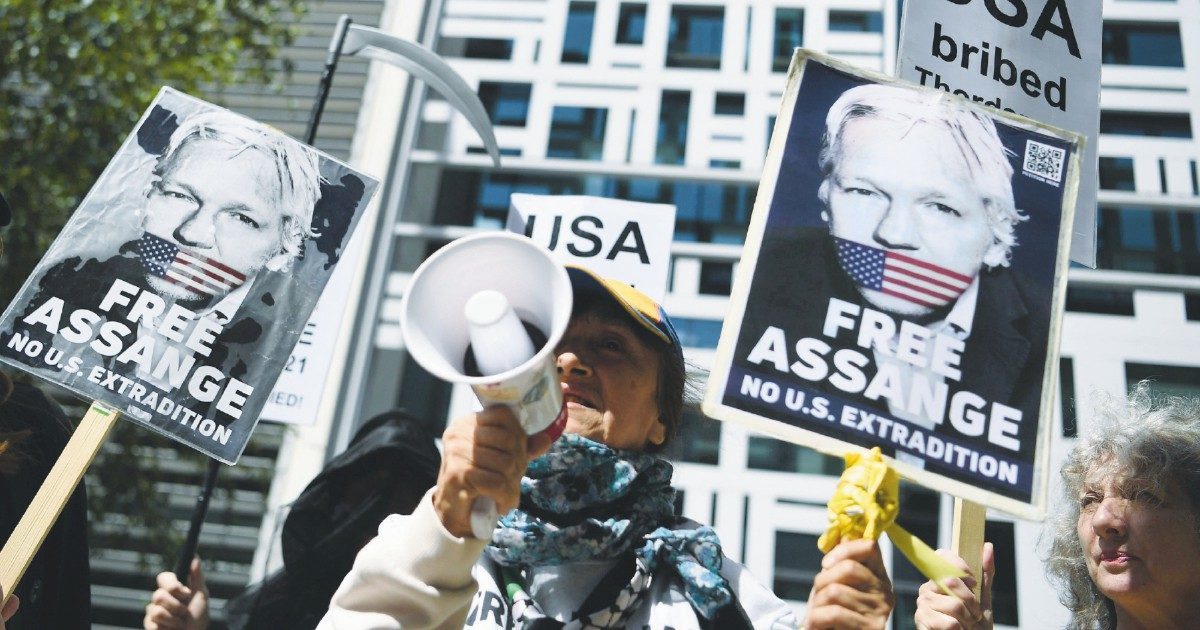The press does not have the right to access the documentation on Julian Assange because, if released, the documents would or could reasonably be expected to cause damage to the international relations of Australia and would divulge information communicated in confidence. That is the ruling recently issued by the Australian Administrative Appeals Tribunal in response to our legal battle to obtain the documents from the Australian Department of Foreign Affairs and Trade (DFAT). A ruling that represents just the latest brick in the wall to bar the Fourth Estate from unearthing what has been happening behind the scenes in the Julian Assange and WikiLeaks case. A case that will decide the limits of press freedom in Western democracies, but also a case marked by glaring violations, like the revelation that in 2017 the CIA, then headed by Mike Pompeo, had planned to kidnap or kill Assange.
Julian Assange remains in Britain’s harshest prison, Belmarsh, waiting for British justice to decide on his appeal against extradition to the United States, where he risks 175 years in prison for obtaining and publishing classified U.S. government files on the wars in Afghanistan and Iraq, U.S. diplomatic cables and files on the Guantanamo detainees. From Amnesty International to the International Federation of Journalists (IFJ), all major organizations for the defense of human rights and freedom of the press have called for the extradition case to be dropped and Assange freed.
Assange, who is an Australian citizen, was arbitrarily detained, according to the UN Working Group on Arbitrary Detention. As documented by the UN Special Rapporteur on Torture, Nils Melzer, he was psychologically tortured. He was also spied on inside the Ecuadorian embassy, where he remained confined until his arrest and incarceration in Belmarsh. The CIA planned to kill him.
Only an independent investigation can thoroughly reconstruct these facts and expose the responsibilities of the authorities involved in these abuses. But an independent investigation is only possible if journalists can access the full documentation on Assange and the WikiLeaks journalists. Since 2015, the author of this article has been trying to obtain it through the Freedom of Information Act, the tool that allows citizens to access government records of public interest.
Four governments – those of the United Kingdom, United States, Australia, and Sweden – have opposed the release of this documentation, thus forcing us to conduct a legal battle in four jurisdictions, where we are represented by seven different lawyers. It is a tremendously difficult and expensive process, but it is only thanks to this effort that important factual information and suspicious facts have come to light.
Britain, for example, has been denying us access to the full documentation since 2015. In the extradition proceeding, the United States is acting through the U.K. Crown Prosecution Service, which is the very same British public authority which was in charge of Assange’s extradition to Sweden when he was under investigation for rape, although he was never charged and the investigation was ultimately dropped. Our legal battle has allowed unearthing evidence that the Crown Prosecution Service contributed to creating the legal and diplomatic quagmire which kept Assange arbitrarily detained, first under house arrest and then in the Ecuadorian embassy for nearly a decade. Why did the Crown Prosecution Service behave that way?
When we dug into this case through our FOIA litigation in Britain, we discovered that the Crown Prosecution Service had destroyed key documents. Why did they destroy crucial documentation about a legal case which was still ongoing and highly controversial? And what did they destroy exactly and on whose instructions? Over the last five years, the Crown Prosecution Service has refused to provide any precise explanation.
When we tried to obtain part of the destroyed documents from Sweden, considering that part of them constituted correspondence between Sweden and Britain, the Swedish authorities resolutely denied holding the thousands of pages of correspondence that the British authorities admitted to having exchanged with them.
Sweden also destroyed an email from the FBI. In the course of our legal battle, the Swedes admitted that the email came from an FBI executive. It is unclear exactly what the email contained, why they destroyed it and what else they destroyed.
As for Australia, it has proved the worst jurisdiction of the four in terms of government transparency. We submitted a FOIA request to the Australian Department of Foreign Affairs and Trade in January 2018 asking for a copy of the full correspondence on the Assange case between the Department and the British Foreign Office and the U.S. State Department from 2016 to 2018.
The Australian authorities released a paltry 24 pages of documents to us, completely redacted with the exception of a few words which do not allow piecing together a single sentence. For the last four years we made every effort to obtain the documentation. Finally, represented by two high-profile Australian lawyers, Peter Bolam and Greg Barns, we sued the Department of Foreign Affairs.
The Australian Administrative Appeals Tribunal has however ruled in favour of the Department. In a decision issued by the Deputy President, Mr. B.W. Rayment, the Tribunal established that the press has no right to access the requested documentation, because if released “it would, or could reasonably be expected to, cause damage to the international relations of the Commonwealth” and “would divulge any information or matter communicated in confidence by or on behalf of a foreign government”.
It is remarkable that the Australian authorities have denied the public access to documents on an Australian journalist whom the CIA planned to extra-judicially kill for publishing truthful information which was in the public interest. Do Australian taxpayers and the public not have the right to know if the Australian government knew of those plans and approved of them?
Though completely redacted, the 24 pages the Department of Foreign Affairs released to us contain a sliver of important information: on May 19, 2017, the very same day that Sweden dropped the rape investigation on Julian Assange, “A Senior Political Officer” assigned to national security at the Australian embassy in Washington DC wrote an email to the Foreign Office or to the U.S. State Department that reads: “In short, following the decision of Sweden’s Chief Prosecutor to close its preliminary investigation and to withdraw the European Arrest Warrant in relation to Mr. Assange, Canberra has sought some initial guidance on [redacted]”. Since the rest of the text is completely redacted, it is impossible to understand what Canberra sought guidance on and what kind of national security matters were discussed with the U.S. or U.K. government.
This email exchange is important, however, because it took place in the weeks when the CIA was furious with Julian Assange and WikiLeaks for publishing Vault 7, a database of secret documents on cyberweapons that make it possible for the CIA to penetrate phones, computers and even smart TVs to spy on conversations and steal documents. A few weeks before this email exchange – precisely at the end of March 2017 – the FBI also was taking an interest in Assange; they sent an email about him to the Swedish authorities, who destroyed it.
According to an investigation published by U.S. media, Yahoo News, and based on conversations with over 30 former U.S. officials, it was precisely after the publication of Vault 7 in March 2017 that the CIA, then headed by Trump-nominated Mike Pompeo, planned to kidnap or kill Julian Assange.
In those weeks when Canberra was seeking “some initial guidance”, did the Australian authorities know about the CIA plans to kidnap or kill him? Il Fatto Quotidiano asked the Australian Department for Foreign Affairs if they ever requested explanations from the US authorities on these plans. The Department did not reply to our question, but commented: “The Department of Foreign Affairs and Trade is aware of media reports on this subject. The Australian Government continues to monitor Julian Assange’s case closely. It is the Government’s view that Mr. Assange’s case has dragged on for too long and should be brought to a close“.
After a decade of right-wing governments, Australia now has a center-left PM, Anthony Albanese, of Italian origin. Many among the supporters of press freedom and human rights are demanding a breakthrough in the Assange case and looking to Albanese with hope. Last month the UN’s highest human rights representative, the High Commissioner for Human Rights, Michelle Bachelet, met the WikiLeaks founder’s legal team, cautioning the British and U.S. authorities against his extradition and declaring that she remains “concerned for his physical and mental well-being”.
Correction: September 30, 2022
An earlier version of this article incorrectly referred to the Commonwealth as “an association of 56 countries which includes Britain and Australia and whose roots go back to the British Empire”, when in fact “Commonwealth” stands for the “Commonwealth of Australia”, i.e. Australia.

